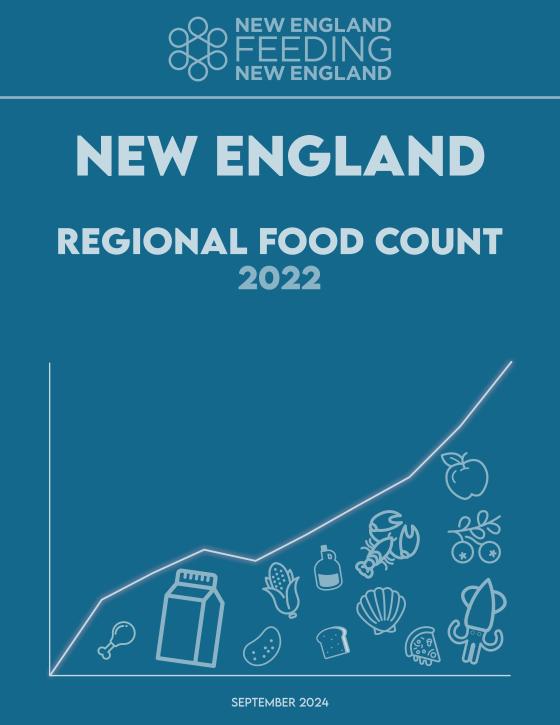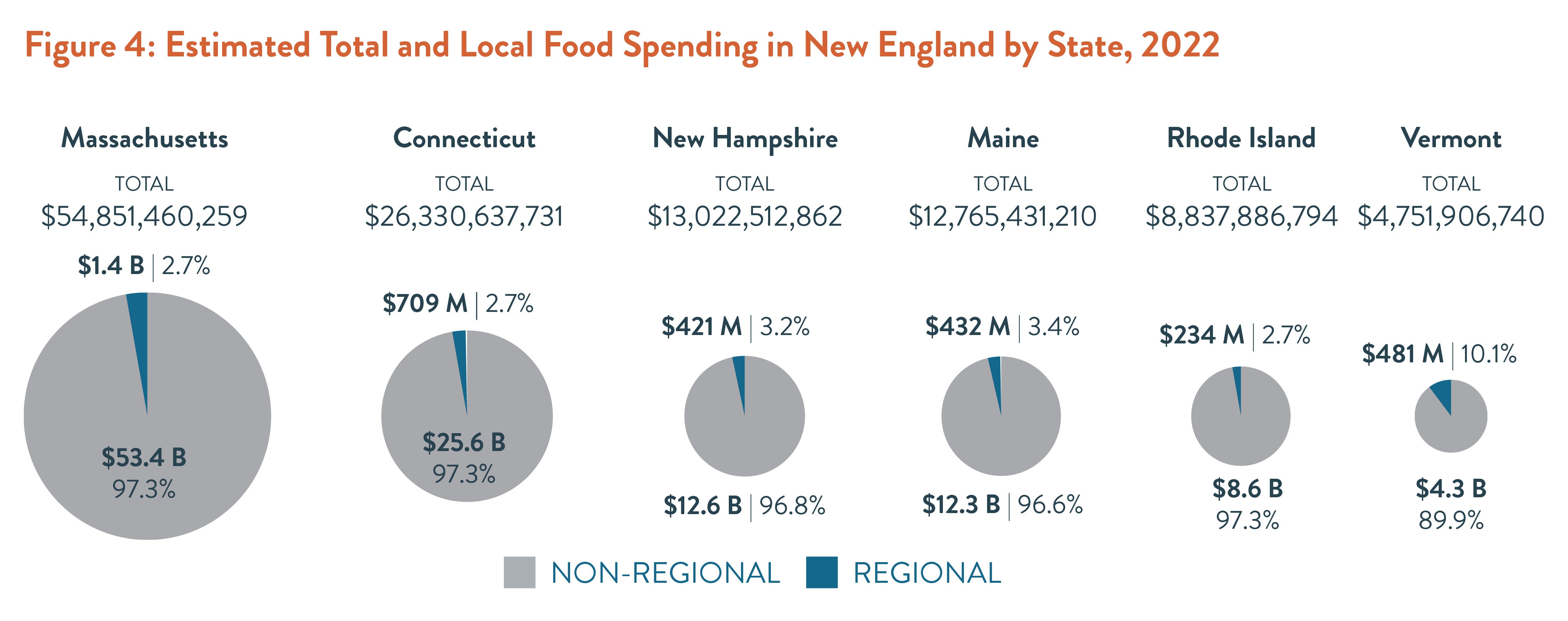Posted September 10, 2024 at 07:54am by kelly@vsjf.org
Local Food Spending Insights Revealed: Room for Growth Needed in Regional Food Consumption

The New England Food System Planners Partnership just released a detailed analysis of local food spending in New England – Regional Food Count 2022. The report reveals that $2.28 billion or 3.1% of New England’s total $120.6 billion in food, beverage and alcohol expenditures were directed towards local and regional products, highlighting a critical area for potential growth and investment.
In this report, ‘local’ is defined as food grown or produced by state and 'regional' is defined as food grown or produced in New England. The report reveals that spending on food and alcohol for at home consumption totaled $55.6 billion, or 46.1%, of the regional total, with the remaining $64.9 billion spent at restaurants and other venues away from home. Spending across just five channels—grocery stores, supercenters, food stores, and limited-service and full-service restaurants—accounted for nearly 70.0% of total state food and alcohol sales. Accompanying the local food count, is an interactive data dashboard, enabling a look at the regional and state level results. Top level state results are included in the graphic below.

Residents and Business Owners Asked to Choose Local Food!
For New England grocery stores, restaurant owners and chefs, sourcing local and regional food can be an economic boost for businesses in the region. By including better signage and labeling on shelves or featuring menu items that promote local farms, seafood, and other seafood producers, this commitment from New Englanders to New Englanders drives sales, keeps dollars close at home and supports jobs for the community.
Institutions such as colleges, hospitals, and schools, have already implemented strategies to expand local and regional food offerings; more can be done through state policy and funding commitments.
“In New England, we have incredible farmers, fishers and producers as well as food businesses, restaurants and institutions that care about growing, sourcing and providing local and regional food to our communities,” said Leah Rovner, Director of the New England Food System Planners Partnership. “New Englanders and visitors alike want to support these businesses and need to be given increasingly more opportunities to do so.”
Residents and business owners can help strengthen our regional food economy by choosing local and regional food when making purchases, keeping our dollars closer to home.
“The single best way we can make a difference now is to choose local and regional food items over those from far away. By shifting even just $10 per week from your existing current food purchases to local or regional food items goes a long way toward supporting our regional food economy," said Rovner.
Goal: 30% Consumption of Regional Food Products by 2030
The local food count data collection is part of a greater effort to reach a regional goal of producing and consuming 30% of New England’s food needs in the region by 2030. In 2023, the New England Food System Planners Partnership, a collaboration between seven state-level organizations, six-state agricultural, economic and environmental department representatives and Food Solutions New England (FSNE), released A Regional Approach to Food System Resilience. The research explores the opportunities and needs along the food supply chain in New England, and highlights the land, sea, and labor needs of the region, consumer purchase metrics, distribution trends, and population projections that will impact the region’s ability to feed itself in the coming years.
"This data will encourage the region to work more collaboratively towards the 30% by 2030 goal,” said Ellen Kahler, Executive Director of Vermont Sustainable Jobs Fund, which manages Vermont Farm to Plate. “By equitably expanding our regional food system, we can strengthen New England’s economy, be more climate resilient and food secure. It is going to take all of us working together – businesses, community groups, governmental agencies, and eaters – to reach this goal but we all have a role to play and we will be better off for it."
The Need to Capture Future Local Food Counts
This data serves as a baseline for future assessments, with subsequent counts planned for 2025 and 2030. The report also identifies gaps in current data, such as specific product details, and suggests areas for improvement in both data collection and local food system support.
About the New England Food System Planners Partnership
The New England Food System Planners Partnership (NEFSPP) is a collaboration among seven state-level food system organizations, six-state agricultural, economic and environmental department representatives and Food Solutions New England (FSNE), a regional network that unites the food system community. Together, they are mobilizing regional networks to impact local and regional food supply chains and strengthen and grow the New England regional food system. The Partnership disseminates information on trends, challenges and opportunities to hundreds of groups across the region that connect with our individual state initiatives. The Partnership is fiscally sponsored by the Vermont Sustainable Jobs Fund.
About Food Solutions New England
Food Solutions New England (FSNE) is a regional, multi-racial, six-state network that unites the food system community around a shared set of values – democratic empowerment, racial equity and dignity for all, sustainability, and trust – and strengthens the movement’s ability to achieve the New England Food Vision of 50% x 2060. They are organized around 4 overlapping impact areas: Visionary Policy, Network Building & Strengthening, Racial Equity & Values Leadership and Narrative Strategy.
About Farm to Institution New England
Farm to Institution New England (FINE) is a six-state network of nonprofit, public and private entities working together to transform our food system by increasing the amount of good, local food served in our region’s schools, hospitals, colleges and other institutions. FINE’s mission is to mobilize the power of New England institutions to transform our food system.The FINE network consists of non-profit organizations, government agencies, institutions, foundations, farms, food distributors, food processors, food service operators and others.
